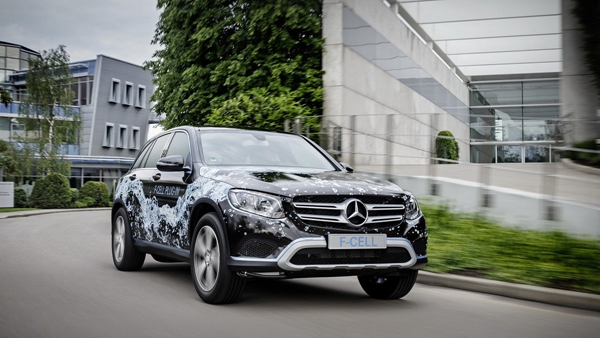
奔驰近日发布了GLC F-CELL插电燃料电池车,该车绝非一辆普通的氢燃料电池车。奔驰为其配备了插电混动系统,可以为车载的锂电池充电,充满电后在纯电动模式下续航里程为48.2公里。而如果将两个碳纤维包裹的氢燃料罐(每个重量为4千克)加注满以后,总计续航里程为500公里。将氢燃料罐完全加注满仅需3分钟,与普通内燃机车型加油时间差不多。该车额外增加的锂电池组不仅有助于增加续航里程,还为那些担心氢燃料耗尽后无法继续行驶的消费者免除了后顾之忧。该车将于明年底在德国、日本和美国上市,英国上市时间为2018年。目前还不清楚该车价格,但E-Drive System Integration老板Jurgen Schenk几天前透露“该车价格可以被消费者接受”。另外,奔驰计划在今年巴黎车展发布纯电动概念车。该车将采用独特造型并将于2020年推出其量产版车型,续航里程将达到500公里。
Mercedes GLC F-CELL plug-in hydrogen prototype revealed
Announced at the beginning of the year, the Mercedes GLC F-CELL won’t be an ordinary hydrogen vehicle. That’s because it will have plug-in capabilities to charge the on-board lithium-ion battery pack which will have enough energy for around 30 miles (48.2 kilometers). Total range will stand at approximately 310 miles (500 km) if we factor in the two carbon fiber-encased hydrogen tanks that can each hold around 8.8 lbs (4 kilograms) of hydrogen. A full refill of those two tanks will take about three minutes, so it’s going to be roughly the same as with a conventionally-powered car.
The extra range provided by the lithium-ion batteries is going to be a nice addition and should make the Mercedes GLC F-CELL a more interesting model among people worried about range anxiety. It will be interesting to see what sort of performances the hydrogen compact crossover will be able to deliver given the weight penalty caused by the additional hardware.
Daimler’s first truly commercially available hydrogen vehicle is slated to go on sale towards the end of next year in key markets such as Germany, Japan, and United States, with U.K. getting the model in 2018. There’s no word about pricing, but E-Drive System Integration boss Jurgen Schenk announced a few days ago during the prototype’s reveal in Stuttgart it will have a “price the customers will accept.”
In related news, Mercedes has confirmed plans to bring an all-electric concept to the Paris Motor Show set for early October. The vehicle in question will have distinctive styling and will spawn a production version due to arrive before the end of the decade with a maximum range of 310 miles (500 km).